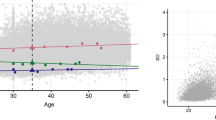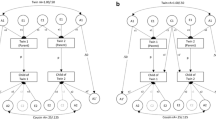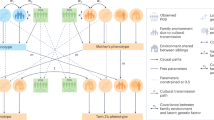Abstract
The aim of this study was to explore, in a large and non-censored twin cohort, the nature (i.e., additive versus non-additive) and magnitude (i.e., heritability) of genetic influences on inter-individual differences in human longevity. The sample comprised all identified and traced non-emigrant like-sex twin pairs born in Denmark during the period 1870–1900 with a zygosity diagnosis and both members of the pairs surviving the age of 15 years. A total of 2872 pairs were included. Age at death was obtained from the Danish Central Person Register, the Danish Cause-of-Death Register and various other registers. The sample was almost non-censored on the date of the last follow-up (May 1, 1994), all but 0.6% had died, leaving a total of 2872 pairs for analysis. Proportions of variance attributable to genetic and environmental factors were assessed from variance-covariance matrices using the structural equation model approach. The most parsimonious explanation of the data was provided by a model that included genetic dominance (non-additive genetic effects caused by interaction within gene loci) and non-shared environmental factors (environmental factors that are individual-specific and not shared in a family). The heritability of longevity was estimated to be 0.26 for males and 0.23 for females. The small sex-difference was caused by a greater impact of non-shared environmental factors in the females. Heritability was found to be constant over the three 10-year birth cohorts included. Thus, longevity seems to be only moderately heritable. The nature of genetic influences on longevity is probably non-additive and environmental influences non-shared. There is no evidence for an impact of shared (family) environment.
Similar content being viewed by others
References
Berg K (1994) Lp(a) lipoprotein: an overview. Chem Phys Lipids 67/68:9–16
Christensen K, Vaupel JW, Holm NV, Yashin AI (1995) Mortality among twins after age 6: fetal origins hypothesis versus twin method. BMJ 310:432–436
Cohen BH (1964) Family pattern of mortality and life-span. Q Rev Biol 39:130–181
Fisher RA (1930) The genetical theory of natural selection. Clarendon, Oxford
Hauge M, Harvald B, Fischer M, Gotlieb-Jensen N, Juel-Nielsen N, Raebild I, et al (1968) The Danish Twin Register. Acta Genet Med Gemellol (Roma) 2:315–331
Hauge M (1981) The Danish twin register. In: Mednick SA, Baert AE, Bachmann BP (eds) Prospective longitudinal research. Oxford Medical, Oxford, pp 217–222
Heath AC, Neale MC, Hewitt JK, Eaves LJ, Fulker DW (1989) Testing structural equation models for twin data using LISREL. Behav Genet 19:9–35
Holm NV (1983) The use of twin studies to investigate causes of diseases with complex etiology with a focus on cancer (in Danish). Thesis, Odense University, Odense
Hrubec Z, Neel JV (1981) Familial factors in early deaths: twins followed 30 years to ages 51–61 in 1978. Hum Genet 59:39–46
Jarvik L, Falek A, Kallmann FJ, Lorge I (1960) Survival trends in a senescent twin population. Am J Hum Genet 12:170–179
Kervinen K, Savolainen MJ, Salokannel J, Hynninen A, Heikkinen J, Ehnholm C, et al (1994) Apolipoprotein E and B polymorphisms — longevity factors assessed in nonagenarians. Atherosclerosis 105:89–95
Lykken DT (1978) The diagnosis of zygosity in twins. Behav Genet 8:437–473
Lykken DT (1982) Research with twins: the concept of emergenesis. Psychophysiology 19:361–373
Lykken DT, McGue M, Tellegen A, Bouchard TJ (1993) Emergenesis. Genetic traits that may not run in families. Am Psychol 47:1565–1577
Mayer PJ (1991) Inheritance of longevity evinces no secular trend among members of six New England families born 1650–1874. Am J Hum Biol 3:49–58
McGue M, Vaupel JW, Holm N, Harvald B (1993) Longevity is moderately heritable in a sample of Danish twins born 1870–1880. J Gerontol 48:B237-B244
Neale MC, Cardon LR (1992) Methodology for genetic studies of twins and families, 1st edn. Kluwer, Dordrecht
Neale MC (1994) Mx: statistical modeling, 2nd edn. Department of Psychiatry, Box 710 MCV, Richmond, VA 23298, USA
Pearl R (1931) Studies on human longevity. IV. The inheritance of longevity. Hum Biol 3:245–269
Roff DA, Mousseau TA (1987) Quantitative genetics and fitness: lessons from Drosophila. Heredity 58:103–118
Schächter F, Cohen D, Kirkwood T (1993) Prospects for the genetics of human longevity. Hum Genet 91:519–526
Schächter F, Faure-Delanef L, Guénot F, Rouger H, Froguel P, Lesueur-Ginot L, et al (1994) Genetic associations with human longevity at the APOE and ACE loci. Nature Genet 6:29–32
Sørensen TIA, Nielsen GG, Andersen PK, Teasdale TW (1988) Genetic and environmental influences on premature death in adult adoptees. N Engl J Med 318:727–732
Vaupel JW (1988) Inherited frailty and longevity. Demography 25:277–287
Wyshak G (1978) Fertility and longevity in twins, sibs, and parents of twins. Soc Biol 25:315–330
Yashin Al, Iachine IA (1995) Genetic analysis of durations: Correlated frailty model applied to survival of Danish twins. Genet Epidemiol 12:529–538
Author information
Authors and Affiliations
Rights and permissions
About this article
Cite this article
Herskind, A.M., McGue, M., Holm, N.V. et al. The heritability of human longevity: A population-based study of 2872 Danish twin pairs born 1870–1900. Hum Genet 97, 319–323 (1996). https://doi.org/10.1007/BF02185763
Received:
Revised:
Issue Date:
DOI: https://doi.org/10.1007/BF02185763




